10 Best Rifle Scopes under $300 in 2024 – Reviews & Top Picks
Last Updated on
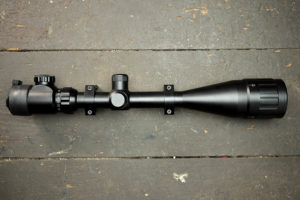
Believe it or not, now is actually a wonderful time to be shopping for a scope. Even though ammo is almost impossible to find, optics are fairly available and the market has become so much more competitive over the last few years with incredible scopes at fantastic prices. You can get some phenomenal glass for under $300 these days, and the competition was so fierce it was tough to narrow it down to the 10 best options.
A lot of this depends on what you’re looking for; we’ve included reviews for long-range scopes, low power variable optics (LPVOs), and everything in between so no matter what you’re looking for, you should be able to find a great option on this list. Along with all the great scopes, there are some garbage ones out there too, and the last thing you want to do is waste the money and time on a scope that falls apart on your first outing.
A Quick Comparison of Our Favorites
| Image | Product | Details | ||
|---|---|---|---|---|
| Best Overall |
 |
Vortex Optics Crossfire II Riflescopes |
|
CHECK PRICE |
 |
UTG BugBuster 3-9x32 Riflescope |
|
CHECK PRICE | |
 |
Leupold VX-Freedom 3-9x40mm Riflescope |
|
CHECK PRICE | |
 |
Athlon Optics Argos BTR Riflescope |
|
CHECK PRICE | |
 |
CVLIFE Hunting Rifle Scope |
|
CHECK PRICE |
The 10 Best Rifle Scope under $300 – Reviews 2024
1. Vortex Optics Crossfire II Riflescopes – Best Overall

The Crossfire II has definitely earned its rating as best overall. The image is clear and sharp, you have a few different reticle options to choose from that are fairly minimalist but effective, and it can hold up to tough recoil without losing zero and without sustaining damage.
Even better, you can get the Crossfire II with different magnification ranges. It goes down to 1-4x (although that configuration has a 30 mm tube instead of 1-inch for some reason), and all the way up to 4-12x for long-range shooting. The 1-4x works great out to 100 yards for MOA accuracy and out to 200 yards for bigger targets. If you’re shooting out further, you can always add magnification.
The Crossfire II line isn’t perfect, though. You can only get an illuminated version of the 3-9x, you’ll pay extra for it, and it’s just the center dot. No parallax adjustment even on the 4-12x, although the turrets are finger adjustable and resettable to zero after you sight in the scope. If you are looking for all the bells and whistles for under $300, the Crossfire II won’t get you there.
That said, if you want a durable scope with a wide variety of magnification choices, good reticles, and a clear and sharp image, the Crossfire II is hard to beat.
- Many different configurations
- Great image quality
- Highly durable
- Good reticle choices
- Affordable price
- No parallax adjustment
- Illumination is limited
2. UTG BugBuster 3-9×32 Riflescope

The BugBuster is not the cheapest scope on this list, but it may certainly qualify as the best for the money. It’s tough to find an affordable scope with resettable turrets, good illumination, a mil-dot reticle, and adjustable parallax, and yet the BugBuster does it for under $100. Readers familiar with scopes are probably not surprised to see the BugBuster on this list.
It even comes with mounting rings that are quick-detach (QD). The 3-9x magnification is a fairly flexible range that can get you out to 300 yards for most types of shooting and can be used very close up as well.
The reticle is second focal plane, as you might expect, so if you shoot at less than the maximum magnification then the dots won’t technically be accurate, although they can still provide you reference points. Turrets are .25 MOA adjustments and there’s a lot to love about the BugBuster. Their proprietary Emerald Coating is fine and gives you good light transmission, but your field of view and overall image clarity won’t be as good.
It’s definitely tough enough to put on your AR, but you may want to exercise caution if you’re shooting .308 or another heavy load.
- Resettable turrets
- Parallax adjustment
- Red and green illumination
- Mil-dot reticle
- Field of view is not as wide
- Not good for heavy loads
3. Leupold VX-Freedom 3-9x40mm Riflescope

The VX-Freedom barely makes this list because of price, and technically as of the writing of this article, only one configuration of this scope is less than $300, which is the 3-9x40mm with the Hunt-Plex reticle. If you’re willing to go a little higher than $300 but still be in a similar range, you can get a few other reticle options.
The main problem with the VX-Freedom is that it’s Leupold’s most affordable scope, which also means that it is pretty stripped down. No illumination, no parallax adjustment, no resettable turrets, nothing beyond the most basic functions of a scope.
That said, it performs those basic functions extremely well. You will simply not find a better field of view, light transmission, color fidelity, or image clarity at this price point. In addition, Leupold holds all of its scopes to pretty extreme standards of toughness and durability. Even the lenses are coated with military-standard scratch resistance, and the scope as a whole is built like a tank.
It’s easy to underestimate the importance of simply liking what you see through your scope. Even if you don’t technically need the utmost in image quality, you still want to enjoy looking through it. You don’t want your eyes straining and have to be constantly focusing to see the image clearly. Even though the Leupold is the most expensive and has the least features, it’s still worth its high spot on this list.
- Unparalleled image quality
- Extremely durable
- Scratch-resistant lenses
- .25 MOA adjustments
- High price
- No features
4. Athlon Optics Argos BTR Riflescope
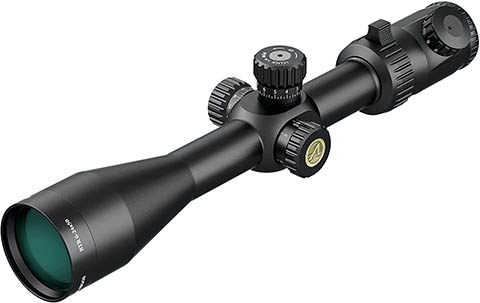
The Argos BTR is one of those mystery scopes that no one really understands how it’s as good as it is at the price point. First things first, it’s a 6-24x scope, so if you’re wanting to shoot at less than 100 yards, this guy is not really a consideration. The Argos BTR is designed to get you out to do some serious long-range precision (LRP) shooting without having to spend over a thousand dollars on a scope.
Everything about it is designed from the ground up for that purpose. It’s a first focal plane reticle, which means the reticle markings will remain accurate even if you’re not at the max magnification. It also has parallax adjustment, which starts to become much more important when you’re shooting at small targets from hundreds of yards away.
Nobody’s shooting form is absolutely perfect each time, not even experienced sharpshooters, so being able to set the parallax to the distance you’re shooting can shave inches off your grouping—as long as you have time to adjust parallax in the first place.
The BTR is great for hunting, although some of its more powerful features aren’t as useful for that purpose.
- First focal plane reticle
- Parallax adjustment
- Aircraft-grade aluminum construction
- Illuminated reticle
- For long-range only
- Wrong feature set for hunting
5. CVLIFE Hunting Rifle Scope

We’ve covered a few scopes on the higher end of our price range, so now let’s talk about one that is nearly at the bottom. The CVLIFE is best looked at as a cheaper alternative to the Athlon Argos BTR. It has all the same basic features as the BTR—illumination, parallax adjustment, etc. But it doesn’t do them as well. The parallax is done via the objective lens instead of a side focus knob, and the light transmission is not nearly as good.
Image clarity is critical at longer distances, and that’s what the CVLIFE misses out on. That said, the turrets are resettable and have ⅛-inch MOA adjustment clicks, which is almost frustratingly small unless you’re out at least a few hundred yards.
The illumination is both red and green and it comes with a mount high enough to keep the objective lens clear of the rifle. There are two reasons you may want to look past the CVLIFE, one of which we already mentioned: the image clarity and brightness, and the other is strength and durability. You don’t shoot at long ranges with a .22 or even .223. Longer distances mean loads with stronger recoil, which in turn means you need a strong scope.
The CVLIFE isn’t fragile per se, but it’s not going to hold up to hundreds of rounds of .308 Winchester. If you only shoot around 100 rounds per year with it then it may be a good pick, but if you do a lot of shooting you may want to buy 3 or 4 all at once.
- Very low price
- Adjustable parallax
- Great for long-range shooting
- Not good for short range
- Image quality isn’t great
- Not very durable scope
6. Bushnell Banner Dusk & Dawn Multi-X Reticle Riflescope
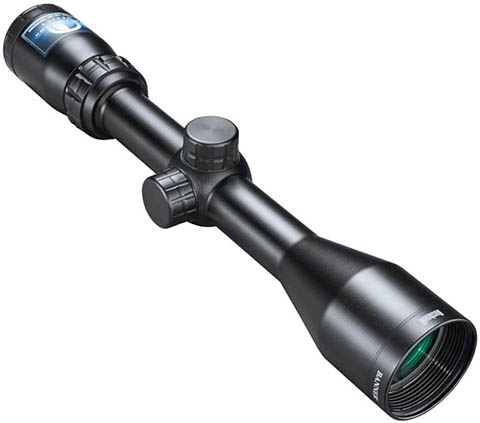
Here is another option for those looking for great image quality on a budget and who are willing to sacrifice bells and whistles. Where the CVLIFE is like a cheaper Argos BTR, the Dusk & Dawn is like a cheaper Leupold VX-Freedom. The image clarity here is quite good and the field of view is nice and wide. Considering that it is less than $100, it’s even more impressive.
The basics are all here which makes this a great beginner scope if you’re just getting into hunting and not sure how much you are willing to commit to it yet. Casual hunters who tag along once or twice a year can get just about all the mileage they’ll need out of the Dusk & Dawn, while more dedicated hunters may want a little more.
No extra features here; the reticle is a duplex with no bullet drop compensator (BDC), there’s no parallax adjustment and no illumination. Turrets are resettable to zero, though, and are capped for protection.
- Less than $100
- Good image quality
- Resettable turrets
- No parallax
- No illumination
- Won’t last as long against heavy recoil
7. Monstrum G3 FFP Rifle Scope
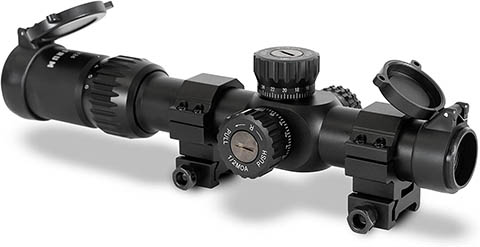
Here’s a weird one—an LPVO with a first focal plane (FFP) reticle. If you’re not sure what an FFP is, we will include a brief explanation down in the buyer’s guide, but suffice it to say that an FFP isn’t particularly useful unless you use the same scope to shoot at widely varying distances; like 300 yards and 1,000 yards with the same scope.
There’s a nugget of wisdom here, though, which is why the G3 is on this list. The range goes from 1x to 6x, and while it seems like it may not quite be a true 1x (more like 1.2x), it still essentially goes from no magnification like a red dot sight to a 6x scope. At 1x, the reticle is so small that it is functionally equivalent to a red dot, but when you crank up the magnification you get enough reticle to reach out to 300 yards with a 100-yard zero.
Be aware that there seem to be some quality control issues with these scopes, but Monstrum’s customer service is fantastic and they do pay a lot of attention to reports of problems. If you’re looking for a tactical LPVO, the Monstrum G3 is a pretty cool choice.
- First focal plane
- 1-6x is highly flexible
- Tough, durable construction
- At 1x, reticle looks like a smudgy dot
- Doesn’t come with throw lever
8. UTG 3-12X44 30mm Compact Scope
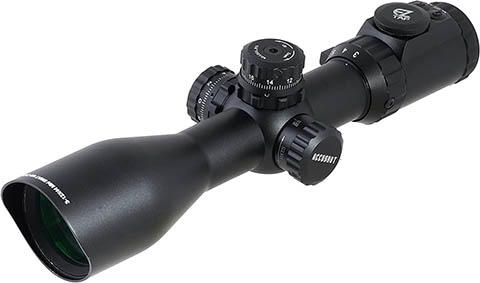
There are a couple of interesting things about this UTG scope that put it above a lot of other scopes competing to be on this list. First is the flexible magnification range from 3x to 12x. At 3x you can still use it for relatively close shooting, although it wouldn’t be open enough for close-quarters battle (CQB). A lot of scopes that start at 3x only go up to 9x, so having a little more on the high end can get you out just a little bit further.
The second is the illuminated reticle. It’s a mil-dot, so it can be used for shooting out pretty far, and the illumination is UTG’s unique 36-color illumination where you can choose from a lot more than just red and green. The different colors are a little bit gimmicky, sure, but if you’ve always wanted a purple reticle then here’s your chance.
Combine those two things with all the basics being done correctly and other features like resettable turrets and parallax adjustment, and the UTG takes the clear lead in front of a lot of scopes that could have been on this list.
- 3-12x magnification
- Multi-color reticle illumination
- Resettable turrets & adjustable parallax
- Image quality is subpar
- Reticle too thick for high accuracy
9. Simmons 3-9x32mm Matte Black Riflescope
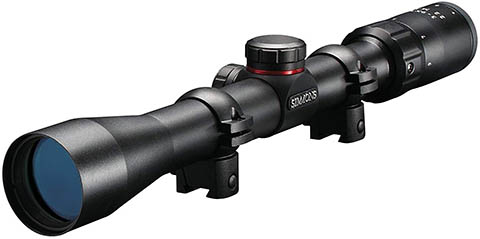
In full transparency, the Simmons is only on this list because of how low its price is. It’s a perfectly serviceable scope, but what takes it from “just decent” to “one of the best” is that it’s so affordable you could buy several of them for the same price as one of the more expensive scopes on this list (and this list is already a collection of budget-friendly scopes).
In other words, even if it breaks, it’s not even that expensive to be a paperweight, especially one as cool as a riflescope. In all seriousness, it’s a straightforward 3-9x 32 mm scope that follows the Leupold no-frills philosophy. It’s a great pick for a .22LR or .17 HMR rifle since it will get you out as far as those rounds can be effective and you aren’t over-investing in a scope for a rifle that may just be for plinking at the range.
Even if you’re doing pest control it is still a great pick. The light transmission will be decent and as long as you’re using it for something with low recoil it should last quite a long time.
- Great for small bore rifles
- Waterproof, shockproof, and fog proof
- HydroShield coating on lenses
- No features beyond the essential
- Light transmission not comparable to more expensive scopes
- Overall image quality not as good either
- Recommended only for low recoil rounds
10. Burris Optics Fullfield E1 Riflescope
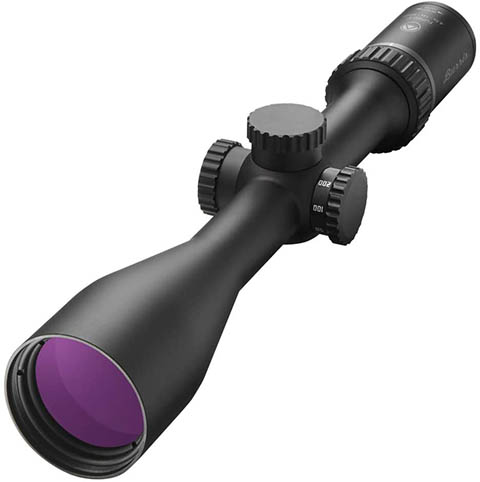
To clarify, this is not the Fullfield II. The E1 is actually an upgrade from the Fullfield II. The E1 comes in a few different configurations, but the one we’re recommending here is the 4.5-14x 42 mm because it offers something a little bit different from the other scopes on the list. You get out a little further but stay close enough that 50-yard shots are still comfortable.
The reticle is designed for MOA accuracy out to long distances, and you get side focus parallax adjustment to help with that as well. It’s a good entry-level option if you want to start getting into competitive shooting. The Fullfield line in general is a great example of a scope line that really punches above its weight and makes you wonder why some other scopes are so expensive.
While it’s definitely a bargain, it has several weak points, including poor light transmission and no reticle illumination.
- 5-14x magnification
- Long Range MOA reticle
- Side focus parallax adjustment
- Light transmission isn’t as great
- Noticeable dip in brightness as you zoom in
- No reticle illumination
Buyer’s Guide
Things To Consider
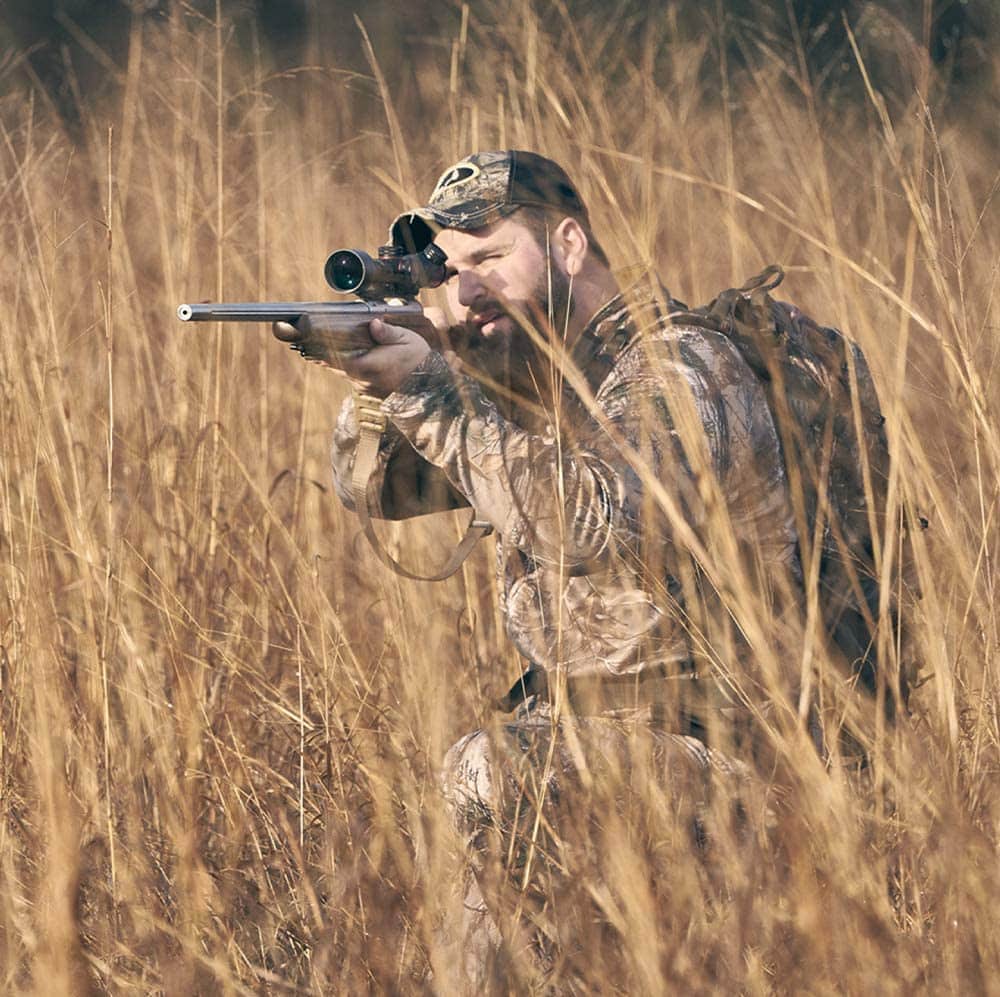
Magnification
It’s fairly common for new shooters to overestimate how much magnification they need for different shots. In most cases, a 9x scope should be able to take you out to 300 yards unless you’re trying to shoot soup cans off a fencepost. Even LRP shooters going out to 1,000 yards often don’t want any more than 18x magnification. If you only want to shoot out to 100 yards, 4x gives you roughly the same visibility as your naked eyes at 25 yards.
- You may also like: How To Adjust a Rifle Scope: Beginner Guide
Image Quality
If you’re doing a form of shooting where MOA accuracy isn’t necessary like hunting or self-defense, then you may be tempted to save money on something with a little less image quality because as long as you can see and identify your target, you’re technically good to go. Only you can decide if that’s the right call, but our recommendation is to prioritize image quality over any non-essential feature.
Looking through a scope isn’t like putting on a pair of glasses and blinking a couple of times; your eye has to constantly strain and focus and work to keep the image sharp and clear—unless you have a high-quality image in the scope. The worse the image quality, the more you have to practice, and the more you will hate practicing because the scope will be unpleasant to use.
Features
Parallax adjustment is nice, but it’s something you only need to worry about if you are doing precision shooting and need that coveted MOA accuracy. If the parallax is fixed at 100 yards and you have fairly consistent eye placement, parallax should never throw your shot off by more than an MOA or two at most. If you’re coyote or varmint hunting at long ranges, it may also be good to have.
Reticle illumination can be a big one, especially if you want to shoot in low-light situations. It can also be nice during the daytime if the area you’re shooting has a lot of shadows or dark-colored objects that make the etched reticle difficult to see.
Terms Explained
Focal Plane
A reticle can be either on the second focal plane (SFP) or the first focal plane (FFP). SFP is what most people imagine when they think of a rifle scope. The reticle is essentially overlaid on the image and is the same size no matter how zoomed in you are on the scope. An FFP reticle is different; it starts out small and grows as you zoom the scope in. The idea here is to keep the meaning of the markings on the reticle the same throughout.
This is nice because if you know the marks will always represent a certain distance, you can estimate bullet drop even if you’re not zoomed in all the way. There are a few situations where this is particularly handy, but the most common one is when you want to shoot at a lot of different distances with the same scope and you may not want to be zoomed in all the way for each of them.
Parallax
Parallax just refers to how the reticle moves in relation to the image through the scope. Objects that are different distances from your eye move independently. If you hold up your thumb so it blocks something from view, then move your head to one side, your thumb is no longer blocking it. That’s all parallax is. Some scopes allow you to adjust the parallax of the reticle to match objects at a specific distance.
This sounds so useful that it should be essential, but in practice, parallax adjustment usually only makes a very minute difference. Having a consistent cheek weld and shooting form is far more important and parallax adjustment can just shave that last MOA or maybe two off of your grouping.
Resettable Turrets
This is another thing that sounds essential when you first hear about it but is just a nice thing to have. This just means that after you’ve sighted your scope in and adjusted the windage and elevation to where it needs to be you can lift the turrets and place them back in the ‘0’ position so that when you adjust for a specific shot later on, you don’t have to count clicks or remember what it was set to previously.
Again, this is nice to have, but it’s also not hard to commit to memory what number the turrets were at when zeroed unless you have a lot of scopes to keep track of.

Conclusion
We hope these reviews were helpful because they were certainly a lot of fun to put together. Our pick for best overall is the Vortex Crossfire II line for its flexibility, image quality, and durability. Our pick for best for the money would be the UTG BugBuster scope. There are so many great scope options out there and the best way to learn about them is just to use them.
Featured Image Credit: Koji Azevedo, Shutterstock
Table of Contents
- A Quick Comparison of Our Favorites
- The 10 Best Rifle Scope under $300 – Reviews 2024
- 1. Vortex Optics Crossfire II Riflescopes – Best Overall
- 2. UTG BugBuster 3-9×32 Riflescope
- 3. Leupold VX-Freedom 3-9x40mm Riflescope
- 4. Athlon Optics Argos BTR Riflescope
- 5. CVLIFE Hunting Rifle Scope
- 6. Bushnell Banner Dusk & Dawn Multi-X Reticle Riflescope
- 7. Monstrum G3 FFP Rifle Scope
- 8. UTG 3-12X44 30mm Compact Scope
- 9. Simmons 3-9x32mm Matte Black Riflescope
- 10. Burris Optics Fullfield E1 Riflescope
- Buyer’s Guide
- Conclusion
About the Author Robert Sparks
Robert’s obsession with all things optical started early in life, when his optician father would bring home prototypes for Robert to play with. Nowadays, Robert is dedicated to helping others find the right optics for their needs. His hobbies include astronomy, astrophysics, and model building. Originally from Newark, NJ, he resides in Santa Fe, New Mexico, where the nighttime skies are filled with glittering stars.
Related Articles:
How to Clean a Refractor Telescope: Step-by-Step Guide
How to Clean a Telescope Eyepiece: Step-by-Step Guide
How to Clean a Rifle Scope: 8 Expert Tips
Monocular vs Telescope: Differences Explained (With Pictures)
What Is a Monocular Used For? 8 Common Functions
How to Clean a Telescope Mirror: 8 Expert Tips
Brightfield vs Phase Contrast Microscopy: The Differences Explained
SkyCamHD Drone Review: Pros, Cons, FAQ, & Verdict



